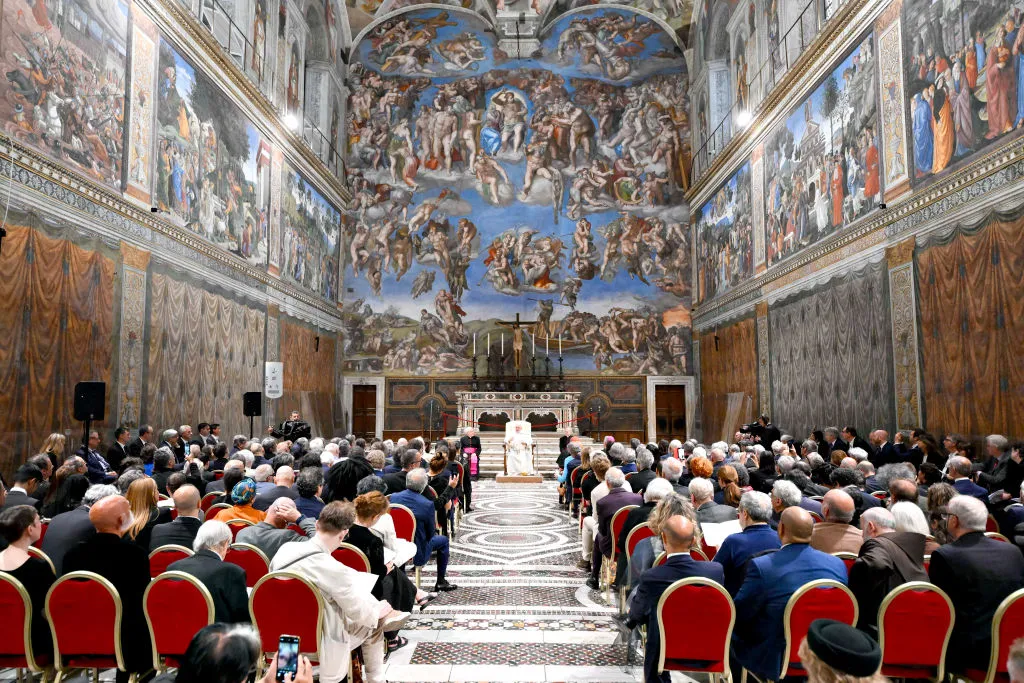
Vatican Media via Vatican Pool/Getty Images
To receive Morning Links in your inbox every weekday, sign up for our Breakfast with ARTnews newsletter.
The Headlines
DIVINE INSPIRATION. On Friday, Pope Francis met at the Sistine Chapel with 200 artists of various kinds, including sometimes-controversial ones like Andres Serrano (of Piss Christ fame), to mark the 50th anniversary of the Vatican’s collection of contemporary art, the New York Times reports. In his remarks, the pontiff told the assembled figures (sculptor Anish Kapoor and director Ken Loach among them): “Like the biblical prophets, you confront things that at times are uncomfortable you criticize today’s false myths and new idols, its empty talk, the ploys of consumerism, the schemes of power.” (Hard to beat praise like that.) Post-event, according to the Associated Press, Serrano said that he took his invitation to be a sign “that the church understands that I am a Christian artist and I am not a blasphemous artist. I am just an artist.”
THE RIGHT STUFF. In the 2010s, reforms in Italy allowed foreigners to helm national museums for the first time, which led to Eike Schmidt (who is German) leading the Uffizi in Florence and James Bradburne (British-Canadian) running the Brera Gallery in Berlin. Now the right-wing government of Giorgia Meloni is aiming to have Italians fill such positions, the Associated Press reports. Listings for some notable museum-director jobs in the country state that applicants have to be European and Italian-proficient. Bradburne, who is retiring in a few months, offered this unfiltered assessment of the situation to the AP: “The problem isn’t that we are foreigners or not foreigners. It is that we have learned the skills to run a modern museum that Italy has not taught two generations of museum professionals.” Italy’s culture minister argues that there are plenty of potential leaders who have been trained at Italian universities.
The Digest
This week will see the opening of the Royal Collections Gallery in Madrid, which will showcase 650 pieces from among the 170,000 items held at palaces and other royal sites around Spain. The eight-story structure, built for €172 million (about $187.4 million), was designed by Emilio Tuñon and Luis Mansilla. [CNN]
A rare portrait of a Black woman and a white woman from around 1650 has been acquired by the Compton Verney Art Gallery in England for more than £300,000 (about $382,000). The work sold at auction in 2021, but the U.K. placed a hold on it to allow a public institution to acquire it and keep it in the country. [The Guardian]
Nine Vermeers were not in the Rijksmuseum’s recent blockbuster retrospective of his work. Documents show that The Guitar Player (1670–72), which is at Kenwood House in London, was not loaned because administrators determined it was too fragile despite experts saying the risk was “negligible.” [The Guardian]
The New York painter Cora Cohen, who created lucid and lively abstractions, has died at 79. She was “one of the most underrated painters in New York,” the critic and poet Barry Schwabskyhas written. [Artforum]
Rita Reif, who began her career at the New York Times creating stock tables and eventually became a revered columnist on antiques and auctions, died on June 16 at the age of 94. [The New York Times]
Dealers championing venturesome art in Lower Manhattan talked with Interview magazine. Taylor Trabulus, of Company gallery, said that “we platform artists that do things outside of just a gallery show every three years. We are really interested in what it means for the gallery to act beyond that.” [Interview]
The Kicker
LIFE LESSONS. Today El País has an expansive interview with architect Elizabeth Diller, whose firm handled the Shed and the most recent MoMA renovation, among other notable projects. While eating “a soft-boiled egg with a teaspoon,” Diller talked about her childhood, taking risks, and teaching. She’s a professor at Princeton, and she shared one method that she’s used with students. “When they had something half-developed, I changed the assignment and asked them to adapt it,” she said. “The exercise destabilized them, they had to rethink everything. They hated me. But they learned a lot.” Prospective pupils: You have now been warned. [El País]


